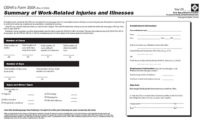OSHA issues final rule to collect injury, illness data for online posting

OSHA today issued a final rule requiring employers in high-hazard industries to send the agency injury and illness data for posting on the OSHA website. Currently, little or no information about the three million worker injuries and illnesses a year is made public or available to the agency.
Competition a factor
OSHA says making the data available will motivate employers to improve workplace safety. Prospective employees can use it to identify workplaces where their risk of injury is lowest. Companies competing to hire the best workers will make injury prevention a high priority.
Additionally, access to the data will allow employers to benchmark their safety and health performance against industry leaders, to improve their own safety programs.
OSHA already requires many employers to keep a record* of injuries and illnesses in order to help these employers and their employees identify hazards, fix problems and prevent additional injuries and illnesses.
A way to "nudge" employers in the right direction
"Since high injury rates are a sign of poor management, no employer wants to be seen publicly as operating a dangerous workplace," said Assistant Secretary of Labor for Occupational Safety and Health Dr. David Michaels. "Our new reporting requirements will 'nudge' employers to prevent worker injuries and illnesses to demonstrate to investors, job seekers, customers and the public that they operate safe and well-managed facilities.
The data will also help OSHA direct compliance assistance and enforcement resources toward establishments where workers are at greatest risk, and enable 'big data' researchers to apply their skills to making workplaces safer.
Who is affected by the rule
Under the new rule, all establishments with 250 or more employees in industries covered by the recordkeeping regulation must electronically submit to OSHA injury and illness information from OSHA Forms 300, 300A, and 301. Establishments with 20-249 employees in certain industries* must electronically submit information from OSHA Form 300A only.
To ensure that the injury data on OSHA logs are accurate and complete, the final rule also promotes an employee's right to report injuries and illnesses without fear of retaliation, and clarifies that an employer must have a reasonable procedure for reporting work-related injuries that does not discourage employees from reporting. This aspect of the rule targets employer programs and policies that, while nominally promoting safety, have the effect of discouraging workers from reporting injuries and, in turn leading to incomplete or inaccurate records of workplace hazards.
The compliance deadline
The new requirements take effect August 10, 2016, with phased in data submissions beginning in 2017. These requirements do not add to or change an employer's obligation to complete and retain injury and illness records under the Recording and Reporting Occupational Injuries and Illnesses regulation. For more information see the news release and blog post by Deputy Secretary of Labor Chris Lu, and visit OSHA's webpage on the final rule, which includes links to a fact sheet and frequently asked questions.
Looking for a reprint of this article?
From high-res PDFs to custom plaques, order your copy today!







.jpg?t=1721257160)